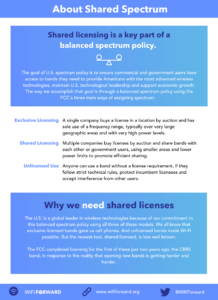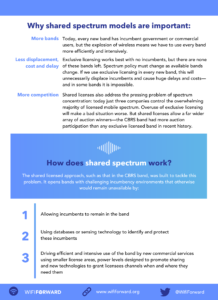New on WifiForward: we bring you a printable resource about shared spectrum.
Shared licensing is a key part of a balanced spectrum policy. The goal of U.S. spectrum policy is to ensure commercial and government users have access to bands they need to provide Americans with the most advanced wireless technologies, maintain U.S. technological leadership and support economic growth.
The way we accomplish that goal is through a balanced spectrum policy using the FCC’s three main ways of assigning spectrum:
- Exclusive Licensing: A single company buys a license in a location by auction and has sole use of a frequency range, typically over very large geographic areas and with very high power levels.
- Shared Licensing: Multiple companies buy licenses by auction and share bands with each other or government users, using smaller areas and lower power limits to promote efficient sharing.
- Unlicensed Use: Anyone can use a band without a license requirement, if they follow strict technical rules, protect incumbent licensees and accept interference from other users.
Why we need shared licenses
The U.S. is a global leader in wireless technologies because of our commitment to this balanced spectrum policy using all three of these models. We all know that exclusive licensed bands gave us cell phones. And unlicensed bands made Wi-Fi possible. But the newest tool, shared licensed, is less well known.
The FCC completed licensing for the first of these just two years ago, the CBRS band, in response to the reality that opening new bands is getting harder and harder.
Why shared spectrum models are important
More bands: Today, every new band has incumbent government or commercial users, but the explosion of wireless means we have to use every band more efficiently and intensively.
Less displacement, cost and delay: Exclusive licensing works best with no incumbents, but there are none of these bands left. Spectrum policy must change as available bands change. If we use exclusive licensing in every new band, this will unnecessarily displace incumbents and cause huge delays and costs—and in some bands it is impossible.
More competition: Shared licenses also address the pressing problem of spectrum concentration: today just three companies control the overwhelming majority of licensed mobile spectrum. Overuse of exclusive licensing will make a bad situation worse. But shared licenses allow a far wider array of auction winners—the CBRS band had more auction participation than any exclusive licensed band in recent history.
How does shared spectrum work?
The shared licensed approach, such as that in the CBRS band, was built to tackle this problem. It opens bands with challenging incumbency environments that otherwise would remain unavailable by:
- Allowing incumbents to remain in the band.
- Using databases or sensing technology to identify and protect these incumbents.
- Driving efficient and intensive use of the band by new commercial services using smaller license areas, power levels designed to promote sharing and new technologies to grant licensees channels when and where they need them.
Learn more at wififorward.org and follow us on Twitter @WifiForward.


